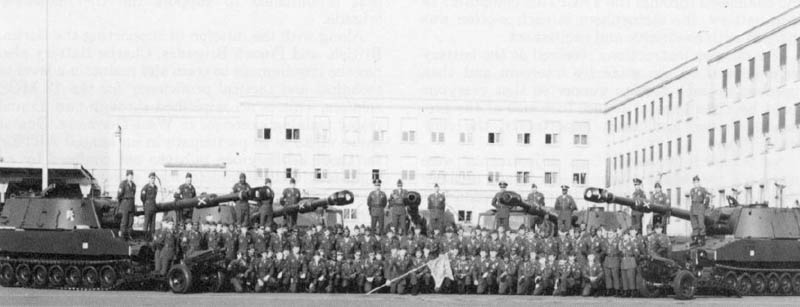This article was published in the Field Artillery Journal in 1981.
BERLIN, WEST GERMANY-On 23 September 1963, the 2d Battalion, 6th Infantry, was the first to welcome Charlie Battery, 94th Field Artillery, to its ranks. The unit's mission was to provide fire support to the Berlin Brigade if renewed conflict should arise in the "divided city". Formerly designated as D Battery, 1st Battalion, 35th Artillery, C Battery, 94th FA, established its new home at Mc Nair Barracks and began the mission of providing timely and accurate artillery fires for the US, British, and French Brigades.
One battery supporting a composite maneuver division? Much like a one-legged man in a kicking contest, C Battery eagerly accepts what appears to be an insurmounable task and more. Basically, the battery consists of six M109A1 howitzers, six M548s, a headquartes element composed of a small maintenance section, and communication, ammunition, supply, and administrative sections. In addition, the battery also contains a fire support element that is intended to support the US maneuver brigade.
Along with the mission of supporting the Berlin, British, and French Brigades, Charly Battery also has the requirement to train and maintain a level of technical and tactical proficiency for the 13 MOS soldiers. This is accomplished through two annual major training exercises in West Germany. One of those visits is to participate in an annual ARTEP for those artillerymen in areas not confined by an eight-foot wall, complete with pyrotechnics. Any travel from Berlin is a time-consuming project. First, the tracked vehicles must rail-loaded in a unique manner for travel through the East German corridor. Second, the wheeled vehicles must travel traverse the corridor via the autobahn according to various regulations that govern the composition, conduct, and rate of travel. By the very nature of its assignment and assets available, this unit rarely gets to participate in coordinated training involving an artillery battalion. In addition, the TACFIRE, BCS, or GLLD systems are not projects for implementaion since the current MTOE does not have the capacity to support such systems. The following equipment and personnel would make the task easier:
- Two additional howitzers in order to implement the split battery concept as an eight-gun battery.
- Additional personnel for the maintenance section to accomplish the ever-present operations for material readiness.
- A full complement of FIST personnel, vehicles radios and associated equipment to firmly establish the nine-man company FIST concept. This would include the assginment of a major as brigade FSO, captains as battalions FSOs, and lieutenants as FIST chiefs.
- Additional wheeled vehicles to support critical areas.
- Artificial training devices to augment the 14.5mm Subcaliber Trainer and the SAAB BT33 Indirect Fire Trainer that are currently in use.
- Also, the battery commander's position should be upgraded to a major since he also serves as brigade fire support coordinator and staff officer to the brigade commander.
How is this done? Like most of today's Army, many of the tactical elements of the brigade are organized under an educations/sports block, guard/detail block and a field/MTA/training block known respectfully as the yellow, red and green blocks.
The officers and NCOs of Charlie Battery rack their brains and ravish the dog-eared pages of their FM 6-20s to "invent" methods to answer and respond to calls for fire from the British and French elements. Tactically speaking, in many exercises designed to research, develop, and test methods of fire support, the brigade FSCOORD/batery commander plays "selective hide and seek" as he attempts to position the battery throughout various locations in the inner city. But, here's the best part, there are no nice figures like 1-22 or 2-33, etc., supporting on the left, right, rear, or even downtown on Berlin's busiest street, the Kurfürstendamm.
Notwithstanding this challenge, C Battery often leaves a CPX/FTX or Camms Exercise with the general consensus "well we wore out two sets of tubes, but we gave 'em hell, didn't we?".
Charlie Battery's soldiers gladly accept the challenge to compete with the remainder of the brigade during the Allied Forces Day parade, Brigade Review, and Independence Day parades by bringing the solid OD green vehicles to a blistering brilliance. Howitzers appear throughout the crowdfilled streets with tracks and track pads painted black with silver exhausts, accented by red and yellow reflective tape. Quite naturally, each track is given its annual pre-parade paint job by the maintenance division. At the same time the "salute" battery, a five-gun 75mm pack howitzer battery, is given a final touch of "Pledge" while "section chiefs" adjust the red scarves and gleaming black helmet liners affectionately known as "Spandau liners."
The soldiers, enlisted men, NCOs, and officers of Battery C, 94th FA, stand proud and flexible as did many other artillerymen since that day in 1963 when the Berlin Brigade welcomed theri first Redlegs eager to accept the challenge to contribute to the defense of Berlin.





